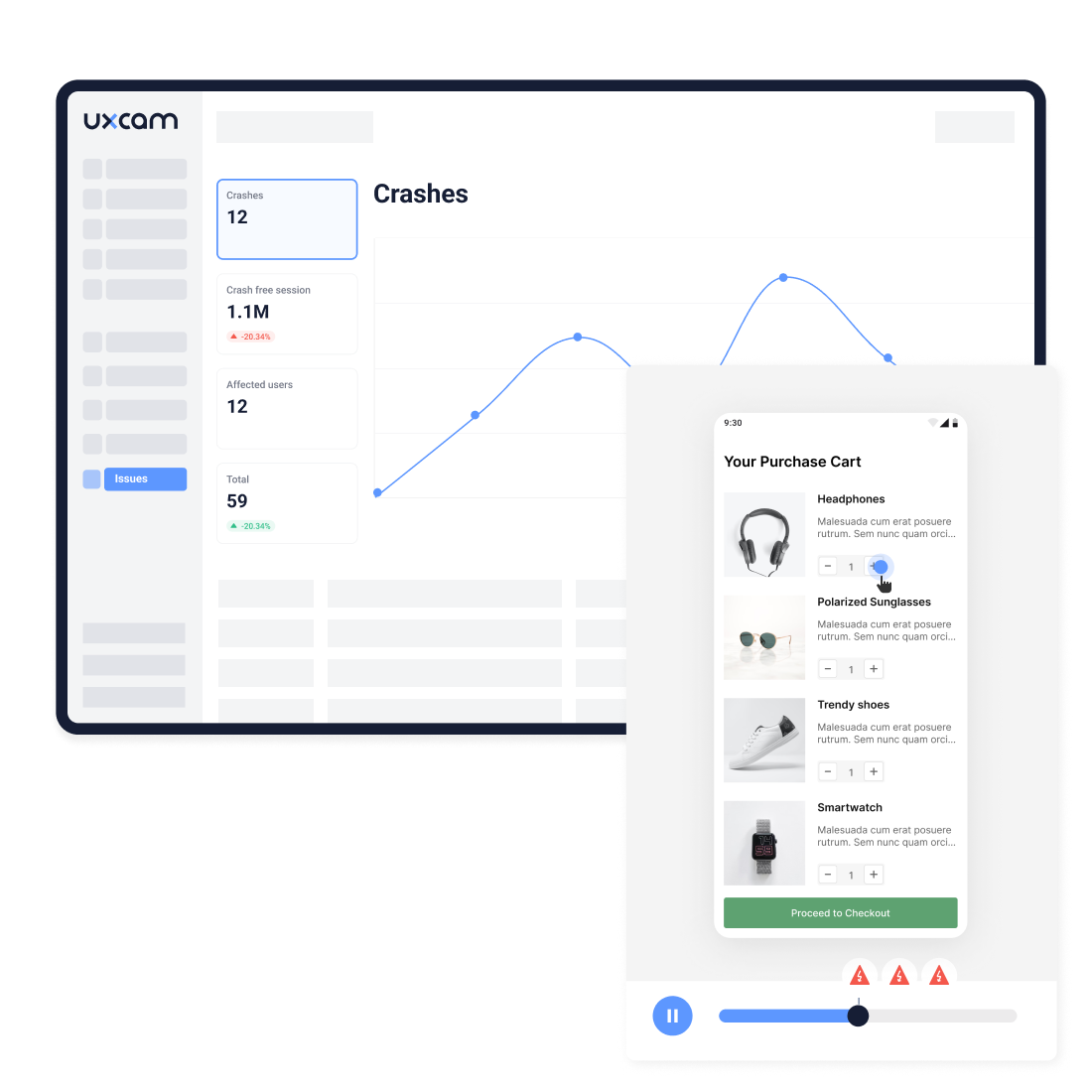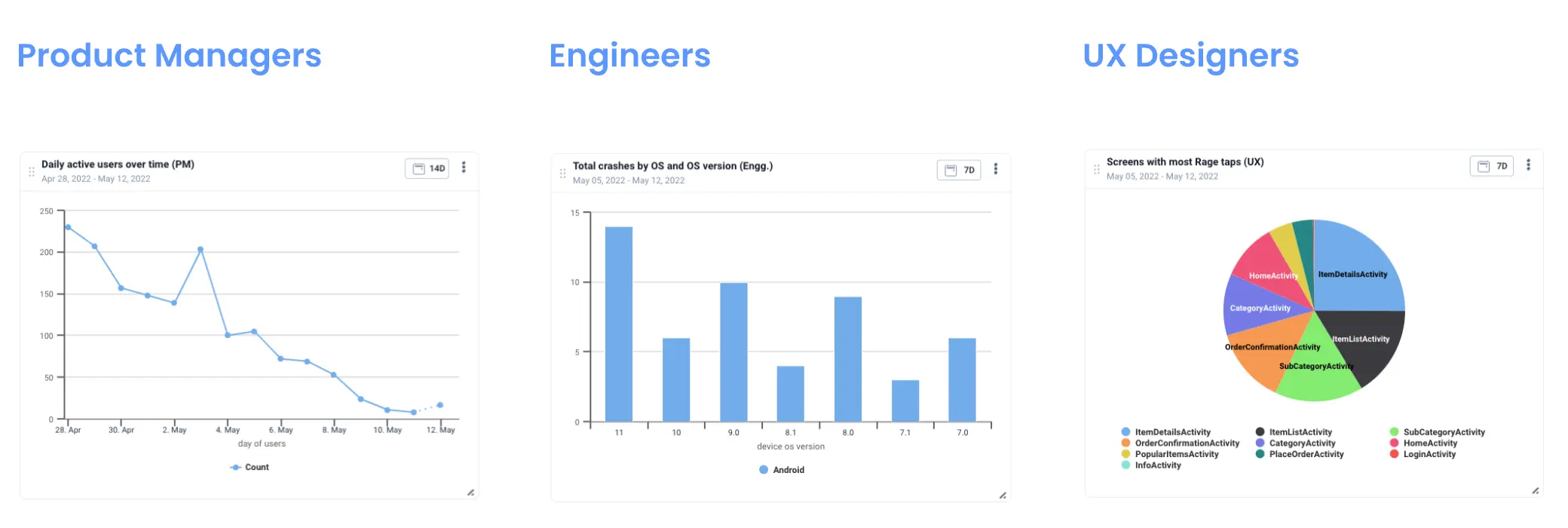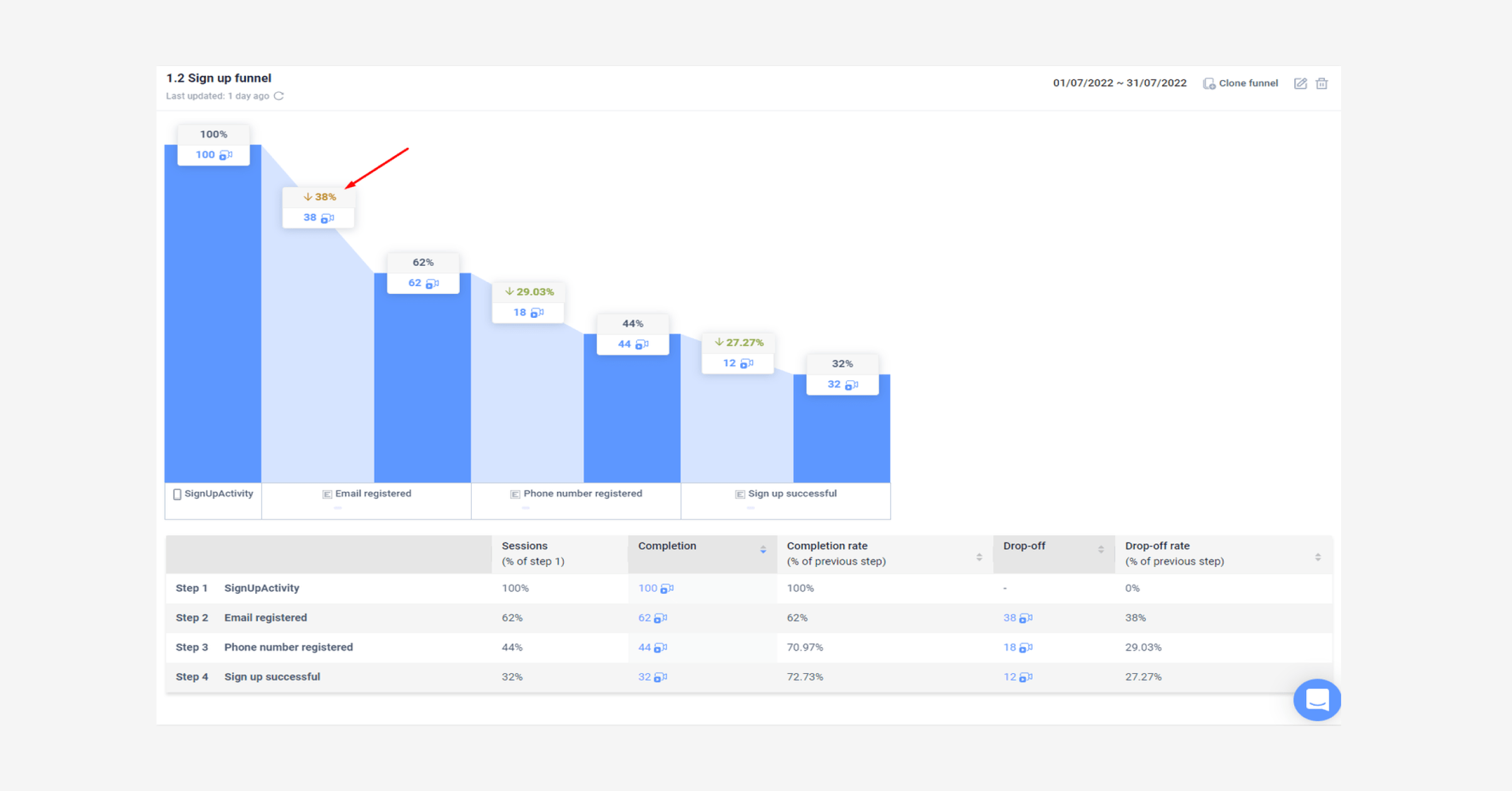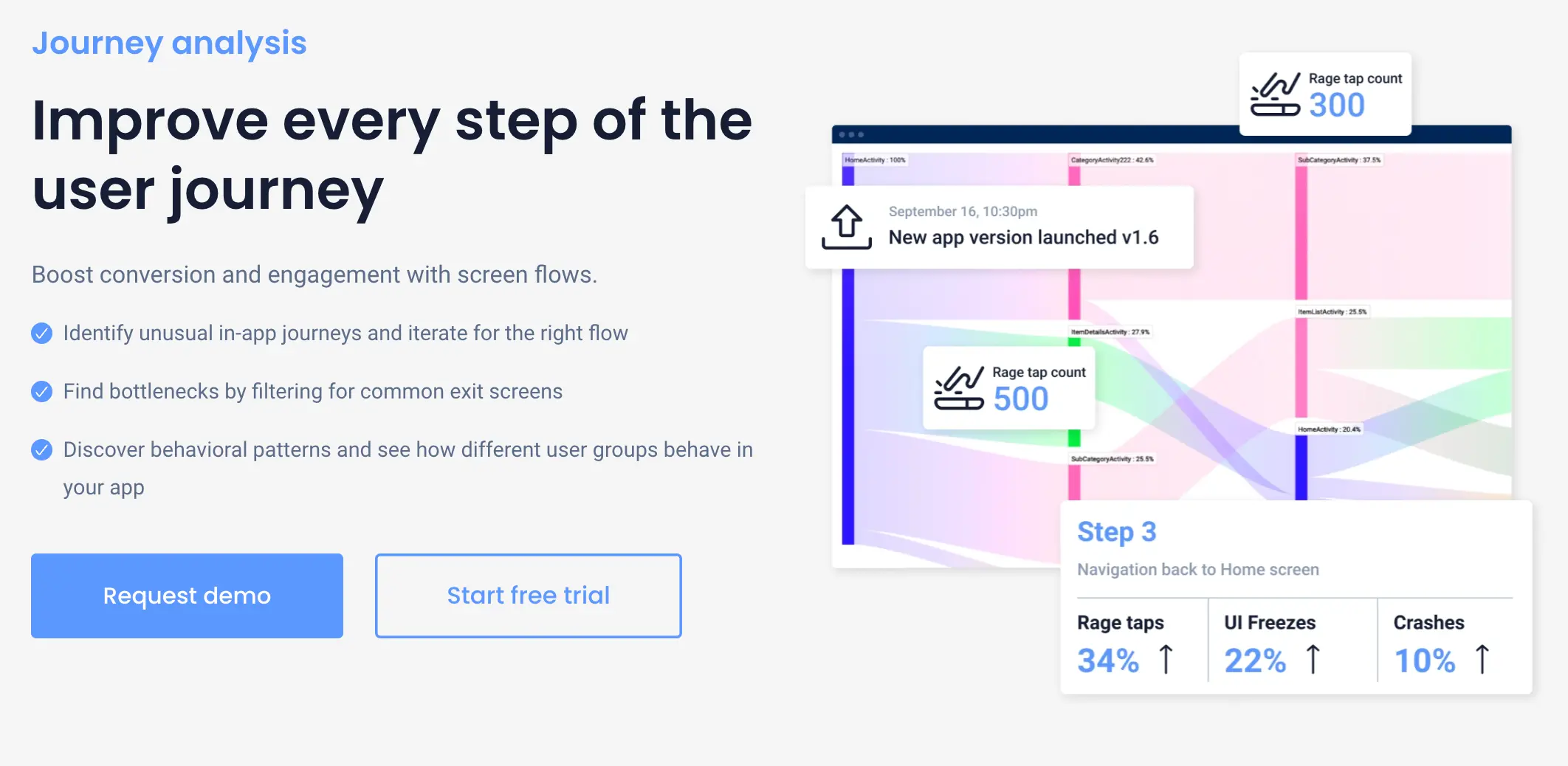Back to blog
6 MIN READ
Customer Engagement Analytics: Using Data to Improve CX
PUBLISHED
21 May, 2023

Product Analytics Expert
Customer engagement analytics is the lifeblood of improving CX. With these analytics, you’ll be able to identify the ‘stickiness’ of your app and how long users stay on your app, alongside other useful insights. This is why the leading behavior analytic tool for mobile apps, UXCam, has stepped in to offer product teams more qualitative insights.
Customer engagement occurs through a variety of channels, and all are integral to success. But today, we’ll cover how mobile app customer engagement analytics can be used for better CX and how UXCam can help you achieve this. So, let’s get started!
What is customer engagement analytics?
Customer engagement analytics refers to the process of tracking and analyzing data from customer interactions and behaviors to gain insights into their engagement levels. It helps you understand and measure the effectiveness of your customer engagement strategies to improve customer satisfaction and drive desired outcomes.
Customer engagement analytics are the techniques and tools used to track the interactions that form a client-business relationship. This raw data is powerful when:
understanding the customer dealings that affect customer behavior;
increasing the number of positive interactions customers have with your business;
gaining in-depth insight and discovering problems that hinder the customer journey;
increasing revenue, customer loyalty, and customer retention;
identifying up-sell opportunities;
simplifying the purchasing cycle;
creating a more personalized experience.
Exceptional CX is only possible with exceptional UX. And UXCam supports mobile app teams to help ensure both are achievable through granular and actionable insights.
Our experience analytics functionality uncovers natural interactions that include mobile session recording, heatmaps, and user journeys for a deep understanding of people’s behavior.


Important customer engagement analytics metrics and examples
UXCam collects customer engagement analytics data from actual in-app mobile behavior. Let’s delve into some of these crucial customer engagement metrics, and how they can give you a deeper understanding of how your users interact with your app.
Active user
Active users are defined as people who engage with your app over time. This gives you an idea of your app’s success, overall popularity, stickiness, and reach. The three most used measurement periods for active users are:
Monthly active user (MAU): is someone who interacted with your app over 30 days.
Weekly active user (WAU): is someone who interacted with your app over 7 days.
Daily active users (DAU): is someone who interacted with an app on a particular day.
Retention
Customer retention rate is the percentage of users who remained loyal after a certain number of days following app installation. It helps you understand engagement over time, how well your app performs, and whether your customers are satisfied. It also gives you an idea of how effectively users meet their objectives within your app.
Churn
The churn rate is the percentage of people who have stopped using the app, usually over one month. This can be a combination of people who are no longer launching the app or have uninstalled it.
Some churn is typical. However, churn rates higher than your company or industry average can indicate a problem with your CX. Businesses should aim for a churn rate of no more than 8% for the best results.
Conversion
Conversion rate is the percentage of your users who have completed a desired call-to-action (CTA). An example of a customer completing a desired action could be upgrading to a paid subscription.
Gather customer engagement analytics with UXCam
Our experience analytics solution includes easy-to-understand, interactive dashboards where your teams can quickly get answers to the questions necessary to make confident design decisions.

You can observe exactly how users naturally use your app to understand them better using our experience analytics features. User journeys, heatmaps, and session replays will help your teams to discover hindrances and opportunities to increase engagement, prevent churn, and optimize conversions. You can even measure new feature adoption amongst your users and any funnels that prevent them from using them effectively.


No two customers thought processes are the same, so we deliver segmentation functionality for quick pattern and trends insight. This data will help you analyze user groups, for example, new, loyal, or users on the edge of churn, to better understand conversion, engagement, and churn drivers.

How to use customer engagement analytics to improve CX
Step 1: Use the right tools
Using different customer engagement tools is common for product teams, especially at the start. However, customer data management done in silos can result in some customers going unnoticed. Using one solution with the right automation and communication functionality is essential to simplify your engagement activities, measure processes, and leverage your engagement analytics.
Use a robust tool to centralize customer engagement activities throughout the lifecycle for seamless CX.
Step 2: Establish a customer-centric vision
How your company serves existing and prospective customers and boosts CX by leveraging CX strategies and analytics need to be clearly defined.
A comprehensive CX concept should be:
uncomplicated and concise;
well-known and duplicatable at all company levels;
backed by stakeholders;
associated with business objectives;
associated with a specific roadmap, including checkpoints.
In addition, decide on what you want the outcomes to be, so consider whether you want to:
increase your app’s popularity?
increase your brand’s equity?
gain more consumer insights for personalization?
achieve all of the above and more.
Furthermore, all your teams should be singing from the same hymn sheet in terms of moving towards the same vision. And be clear on the necessary actions to achieve it. Ultimately, it will be easier to understand the gaps that need filling to satisfy the vision.
Step 3: Segment customers with personalization
You can group your customers into segments based on standard and custom attributes with in-app behavior analytic tools like UXCam. Customer segmentation divides your customer base into smaller groups to better understand each segment’s preferences and unique needs.
Moreover, teams gain in-depth insight into potential behaviors and influences, e.g., probable positive and negative behavior and targeted conversion opportunities for each segment. Plus, smaller chunks of data will be easier to manage, making it much simpler for product teams to notice certain trends among users.
Step 4: Create effective ongoing internal and external conversations
Organizations with limited silos encourage open communication between the business and analytics teams. Customer understanding taken from engagement analytics and feedback can help bring teams together.
In driving change, feedback from internal and external conversations is recommended.
Internal conversations. These are powered by the learning offered by customers with stakeholders. Internal conversations can be a follow-up to customer feedback and for more insight that can be turned into actionable follow-up activities.
External conversations: This type happens with customers and partners. They are the beginning conversations that kick start customer insight and test run possible engagement methods.
Step 5: Identify and re-engage lapsed customers
Your negative engagement metrics are just as valuable as your successful ones. For instance, if your active users are low, that indicates it’s time to engage them. And here are some ways to do that:
Understand why - Behavior analytics will help you understand why users are disengaging. For example, conversion funnels can help you understand where in the process people drop off and their typical drop-off behavior.
Target the right audience. Use your segmentation analytics to remind your users how much you value them by delivering a customized app experience.
Demonstrate app value. You could reach out to past customers to gently remind them of your app’s value and that your products and services are still available for them.
Deliver top-notch CX and UX with UXCam
Leveraging your customer engagement stats to improve CX has many benefits. Not only will your active users, retention, and conversion rates improve, but a customer’s word-of-mouth advertising is powerful. And not to mention free!
The best way to get the most out of your raw data is by understanding the behavior behind it. Knowing why users get confused on certain screens or acknowledging that a particular group of people find a critical task in your design challenging allows teams to make tweaks for better CX for all.
UXCam is for customer-centricity. It gives product app teams deeper granular insight into quantitative data to understand people better and deliver the experience they’re happy to pay for. Request a demo today to discover exactly how we can help you improve CX with data-backed decisions!
Related Articles
Customer experience dashboard examples
Understanding mobile app session replay
Top 5 Customer Experience Tools
AUTHOR

Tope Longe
Product Analytics Expert
Ardent technophile exploring the world of mobile app product management at UXCam.
What’s UXCam?
Related articles
Curated List
Top 19 Mobile App Analytics Tools in 2026
Discover the top mobile analytics tools in 2026. Compare features, pricing, and reviews to choose the right platform for app tracking, behavioral insights, and data-driven...

Jonas Kurzweg
Product Analytics Expert
App Analytics
Mobile App Tracking: Practical Guide & Best Tools [2026]
The best tracking tools for mobile...

Jonas Kurzweg
Product Analytics Expert
App Analytics
Best Android App Analytics Tools in 2026
Discover the top 8 Android analytics including UXCam, Firebase, and Flurry Analytics. Compare features, pricing, and platforms...

Annemarie Bufe
Product Analytics Expert


